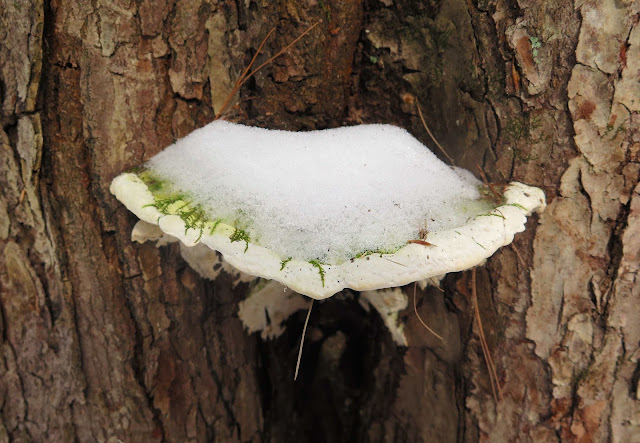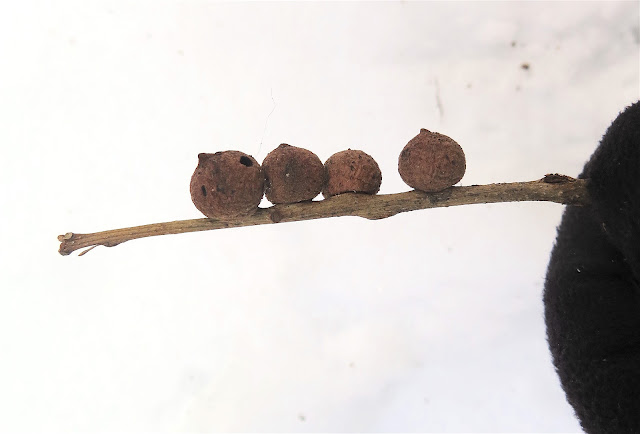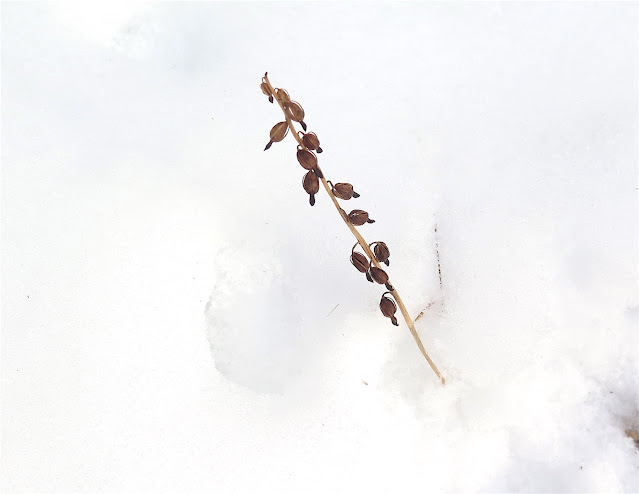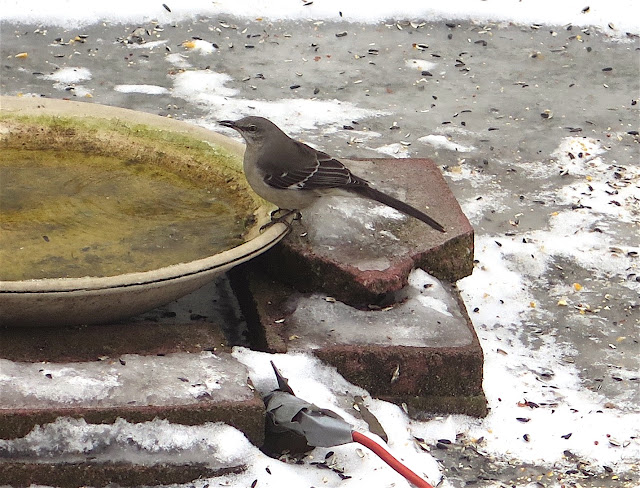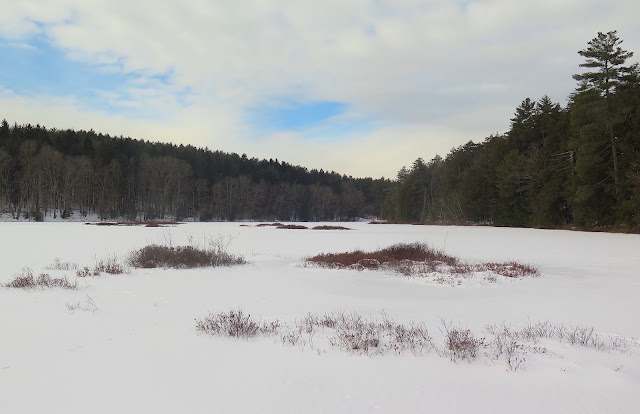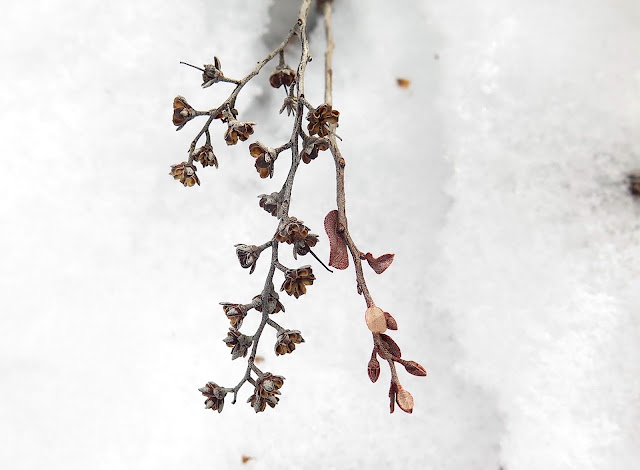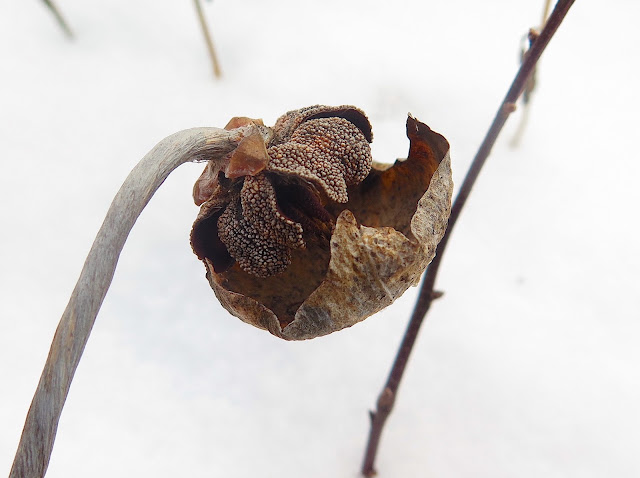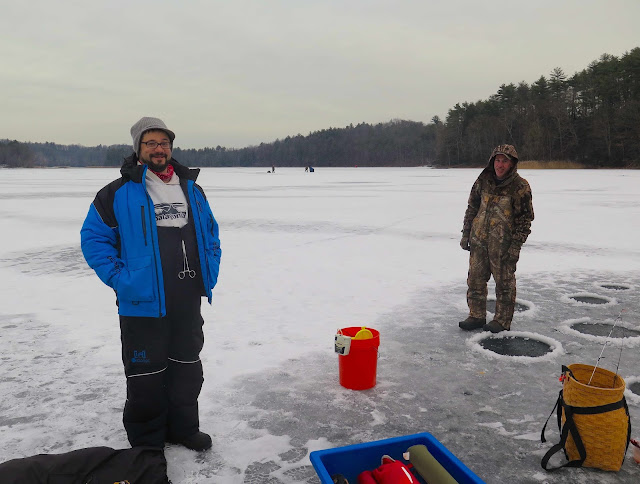Sunday, January 23: Moreau Lake State Park
Ten below ZERO! Gosh, you'd think most folks would hunker down in their cozy homes on a day as cold as this. But today the sun was shining out of a clear blue sky, and by early afternoon the temps had climbed a bit above zero. I'd been nursing a cold all the week before, so I was eager to feel some sun on my face, and I wanted to check out the new skating rink at the park, this first weekend it was open to the public. So I bundled up and headed out to Moreau.
The first thing I noticed was dozens of cars parked along the beach road and many families with young children out on the frozen lake, arrayed around holes in the ice. Oh yes, I now remembered: the park was offering an ice fishing experience for children today, and lots of families had responded. As an extra enticement to overcome fear of frostbite, the park's warming hut was open, too, offering hot dogs and cocoa inside by the fireplace, as well as marshmallows for roasting at a roaring firepit outdoors.
Many folks, too, were enjoying the new skating rink at the beach, zipping around on ice that park staffers had cleared and smoothed for skating. Several fires had been placed around the shore, offering warmth to both skaters and onlookers. This is a new winter activity being offered by the park this year, and I was happy to see so many folks turning out to enjoy it.
Even some little children were enjoying the rink. The nice thing about being as small as this child, you don't have that far to fall. And of course, you are so bundled up in padded snowpants, your tender parts are well cushioned against any "owies."
I noticed, too, that the park has supplied some supportive equipment for those just learning to skate. Or to just scoot around on the ice and have fun with your bigger sisters and brothers.
Heading home from the park, I drove along the Hudson River, noting that ice was building out from the shore. After the several sub-zero days that followed, the ice eventually reached from shore to shore.
Monday, January 24: Lake Bonita at Moreau Lake State Park
Every winter I look forward eagerly to when the ice grows thick on Lake Bonita atop Mt. McGregor in Moreau Lake State Park. Several sub-zero nights have now allowed me to venture safely out to examine the plants that inhabit the little islands that dot the lake's surface. These islets are all thickly covered with Sphagnum Moss, a particular kind of moss that creates an acidic habitat, one that is conducive to the growth of plants best suited to bog or otherwise low pH habitats. I was glad that today the snow cover was light enough to reveal this golden Sphagnum mat at the base of a Leatherleaf shrub.
Here's a cluster of the three most populous shrubs of the little islands: the golden leaves are those of Sheep Laurel (Kalmia angustifolia), the deep maroon leaves are those of Leatherleaf (Chamaedaphne calyculata), and the leafless twigs bearing pointed buds (lower right) are those of Sweet Gale (Myrica gale).
Here's a pair of twigs from a Leatherleaf shrub, the twig on the left bearing the open seed pods that resemble little brown flowers, and the twig on the right bearing the winter-persistent leaves and the buds that will produce next spring's bell-shaped white flowers.
I am always delighted to find female Sweet Gale shrubs filled with cone-shaped seed pods. While not particularly beautiful to look at, they certainly produce a marvelous fragrance when I rub one through my fingers, spilling the tiny seeds on the snow beneath. My fingers will now carry that fragrance until I next wash my hands or my gloves. The scent is very similar to that of Bayberry or Sweet Fern, but even more intensely aromatic.
Other Sweet Gale twigs are laden with buds of the flowers to come in the spring, with pistillate and staminate flowers growing on separate shrubs. I find these flower buds very beautiful, their glossy mahogany-red pointed scales outlined in ivory.
A fourth shrub populates these islands, too, although much more sparsely. But finding the winter remnants of Water Willow (Decodon verticillatus), with its wreaths of seedpods circling the arching stems, is definite proof of this plant's presence out here. I have paddled ponds where masses of Water Willow form impenetrable thickets along the shore, but out here on these tiny islets, it is only an occasional resident.
Some herbaceous plants, too, bear dried remnants that one can recognize even in winter. These tulip-shaped split-open achenes of Marsh St. John's Wort (
Hypericum virginicum) are abundant along the shore of the lake, as well as among the flowers that populate the islands.
It's always fun to come upon the vase-shaped leaves of a Northern Pitcher Plant (
Sarracenia purpurea), but it's a special treat to find one in winter, its normally liquid contents frozen solid and its beautiful color intact.
The colors of its bright-red flowers have faded, though, but much of its fascinating structure remains intact. At least, for occasional specimens. Not all of the Pitcher Plant flowers I found today were this well preserved.
Many Speckled Alder shrubs (Alnus incana) thrive along the lakeshore, as well as growing occasionally out on the islands. Here and there, I found some female cones infected with a fungal plant pathogen called Alder Tongue Gall (Taphrina alni), which causes the cones to produce tangled masses of ribbon-like growths, like those pictured here. I have read that, although it distorts some of the cones of an individual tree, it does not harm the tree itself.
Another common small tree that grows along the shore is Witch Hazel (Hamamelis virginiana). By this time of year, the ribbon-like petals of its fall-blooming flowers have been shed, but the remaining floral calyces are so yellow and flower shaped, once could easily mistake them for small yellow flowers blooming in the dead of winter.
The steep rocky banks of Lake Bonita's north-facing shore are thick with Eastern Hemlock trees, the beautiful green-needled branches adorned now with tiny brown cones. With this conifer species currently under attack by the Hemlock Woolly Adelgid, I hate to imagine our northern forests bereft of this signature tree. I desperately hope that some kind of control will be found effective to combat this menace.
As I climbed the forested hills to return to my car, I was struck by how the ruddy bark of these tall, straight Red Pines (Pinus resinosa) stood out from the typical gray of the surrounding tree trunks. I can certainly see how this stately conifer came by the name Red Pine. I frequently come upon stands of Red Pine whose even rows indicate intentional plantings, but the random distribution of these particular trees in the woods surrounding Lake Bonita suggest that they could have occurred naturally, since this species is native to this part of New York State.
Tuesday, January 25: The Hudson River Shore at Moreau
Finally, my pal Sue Pierce and I found a day when neither she nor I was feeling ill. And the weather cooperated, too, warming enough for us to meet for an extensive walk without suffering from the cold. We even saw a patch or two of blue sky above the mountains that line the Hudson downstream from the Spier Falls Dam. Sub-zero nights had frozen the river completely across. But knowing how river currents can weaken ice cover, we did not venture onto the main river ice, choosing instead to walk a paved county road to a fenced-off water treatment plant, then down through the woods to the shore of the river. We then returned to our starting point by walking through the woods close to the river.
I had thought it would be an easy walk. But I had forgotten about the fierce straight-line winds that had roared through here a few years back, toppling many trees that now lay across our path. We sometimes had to scramble to make our way through the jumble of trunks and branches.
It was obvious that many Coyotes had travelled this route much more easily than we could, for we saw their abundant tracks where the animals had passed easily around, amid, and under the fallen trees. I think my friend found this evidence of largish wild canids a bit disconcerting, but I tried to assure her that any Coyote for miles around had already heard us coming and had hightailed it far away from us.
After pushing and scrambling through blow-down for some distance, I found it quite a relief to step out onto this ice-covered swamp, where the walking was much less burdened. And I loved the view of this rocky little island I used to call Three Pine Island before those winds I mentioned before toppled two of those gigantic pines.
Even though I felt sure that most of the ice-cover here in the swamp was safe to support me, I was aware of where a stream flowed into the swamp and made sure to keep a safe distance from where this stream could have weakened the ice. I did not want to slosh the quarter-mile or so back to my car with saturated snowpants and ice-water-filled boots!
My personal name for this backwater swamp is Tupelo Swamp, suggested by the many Black Tupelo trees (Nyssa sylvatica) that once flourished here. Sadly, most of the tupelos have been girdled by beavers and are slowly dying. This particular cluster of young tupelos was blown over by those roaring winds, and I was struck by how several trunks had managed to remain upright, even though dead. I thought the remaining twisted trunks looked quite gracefully sculptural.
As I re-entered the woods, I passed through a thicket of Highbush Blueberry shrubs (Vaccinium corymbosum) whose reddish twigs and scarlet buds caught my attention. In a winter landscape mostly bereft of vibrant color, such colorful exceptions do stand out!
I also delighted in this sunlit patch of Beechdrops (Epifagus virginiana) looking so sprightly as it cast its shadow on the snow.
The sun that cast that shadow, though, was fading fast. Thick dark clouds were racing across the sky in our direction, and we hurried as quickly as we could up the snow-covered slope that lay between us and our cars. The snow was falling fast by the time we reached the parking area, driven by a fierce wind that was almost frightening in its roaring. But that same wind drove the clouds quickly past us, not allowing much snow to accumulate on the roads as we made our ways home, happy we'd found a day to venture out among these beautiful woods along the Hudson.




